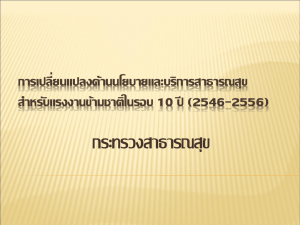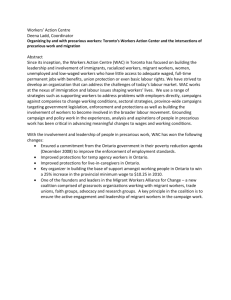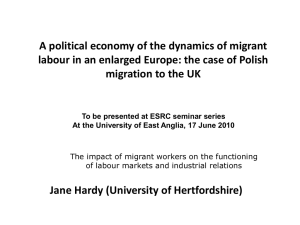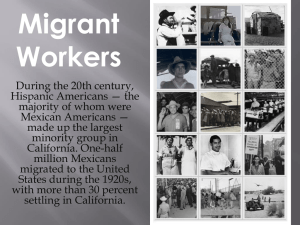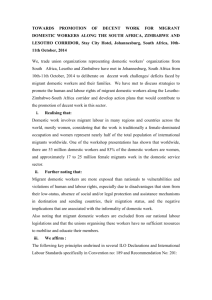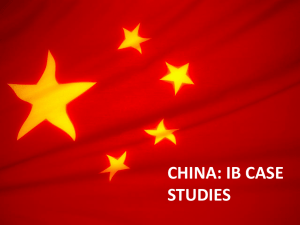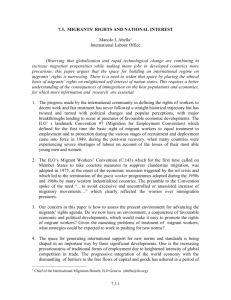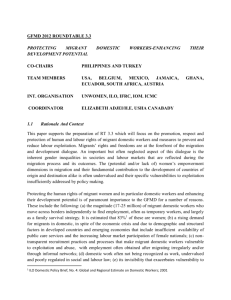Bonaventura Model United Nations
advertisement
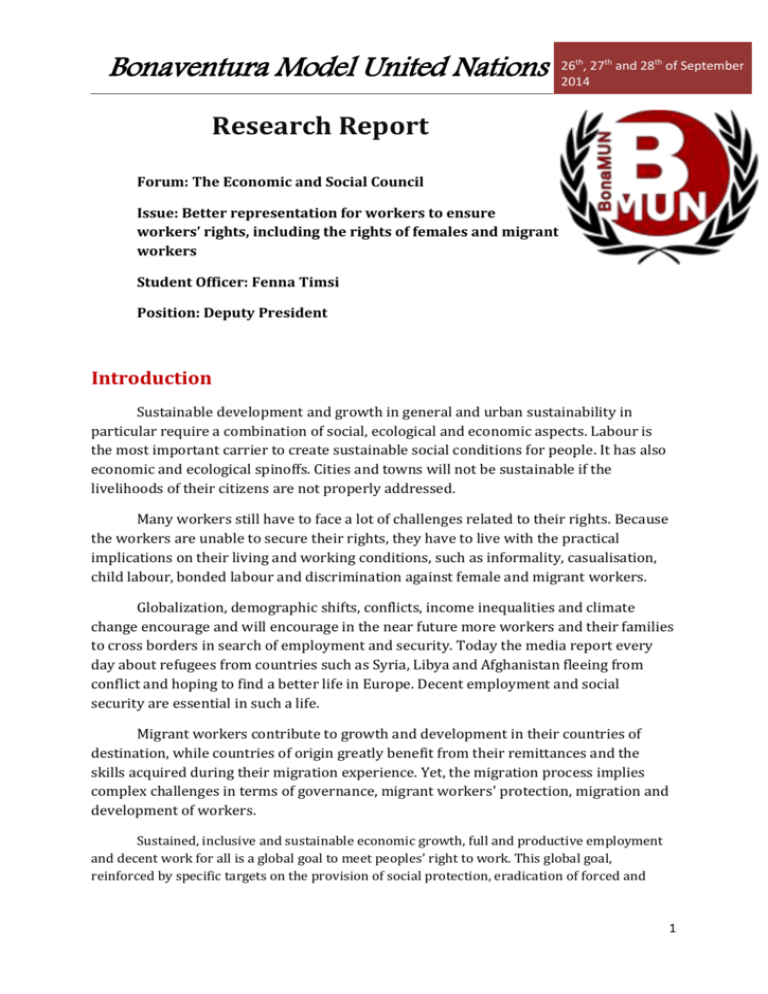
Bonaventura Model United Nations 26th, 27th and 28th of September 2014 Research Report Forum: The Economic and Social Council Issue: Better representation for workers to ensure workers’ rights, including the rights of females and migrant workers Student Officer: Fenna Timsi Position: Deputy President Introduction Sustainable development and growth in general and urban sustainability in particular require a combination of social, ecological and economic aspects. Labour is the most important carrier to create sustainable social conditions for people. It has also economic and ecological spinoffs. Cities and towns will not be sustainable if the livelihoods of their citizens are not properly addressed. Many workers still have to face a lot of challenges related to their rights. Because the workers are unable to secure their rights, they have to live with the practical implications on their living and working conditions, such as informality, casualisation, child labour, bonded labour and discrimination against female and migrant workers. Globalization, demographic shifts, conflicts, income inequalities and climate change encourage and will encourage in the near future more workers and their families to cross borders in search of employment and security. Today the media report every day about refugees from countries such as Syria, Libya and Afghanistan fleeing from conflict and hoping to find a better life in Europe. Decent employment and social security are essential in such a life. Migrant workers contribute to growth and development in their countries of destination, while countries of origin greatly benefit from their remittances and the skills acquired during their migration experience. Yet, the migration process implies complex challenges in terms of governance, migrant workers' protection, migration and development of workers. Sustained, inclusive and sustainable economic growth, full and productive employment and decent work for all is a global goal to meet peoples’ right to work. This global goal, reinforced by specific targets on the provision of social protection, eradication of forced and 1 Bonaventura Model United Nations 26th, 27th and 28th of September 2014 child labour, increasing productivity, addressing youth employment and the development of skills, is the response to the economic and social needs of people and governments everywhere. Even in rich countries work conditions may improve. A lot of people are unaware of the level of discrimination against women that still exists in many forms, such as the pay gap between men and women performing the same jobs. It was not long ago that women were expected to become, for example, a housewife, chaperone or governess and forbidden from having practically any occupation. Over the course of the last century, this situation has changed extensively. In a lot of countries there were movements, such as the women’s suffrage movement. During World War 1 thousands of men left to fight and many women had to take up jobs in factories, or other jobs that before had been exclusively for men. This had the effect that after the war, many more countries, such as The United States, Poland, The United Kingdom, Sweden, Austria and the Netherlands, granted women suffrage, and the right to work where they want. Although there are made a lot of great advances in the fight against discrimination against women, the fight seems far from won. Today a lot of women receive little education or none at all and are forced to accept underpaid jobs as a result of discrimination. Due to the fact that 70 per cent of the world’s population suffering from poverty exists of women, they often lack basic human needs. This leaves women in no ability to defend themselves and to stand up for their rights. This makes clear why women are often manipulated and recruited for cheap labour. Definition of Key Terms Livelihood Assets allowing individuals or communities to meet their basic short- and longerterm needs. These include earning a living, but also access to property and natural resources, systems of savings, social networks and education. Suffrage The right to vote Migrant A migrant will be seen as a person whom chooses to move in order to improve the future prospects of themselves and their families. Millennium Development Goals (MDGs) 2 Bonaventura Model United Nations 26th, 27th and 28th of September 2014 The Millennium Development Goals are the eight international development goals that were established following the Millennium Summit of the United Nations in 2000, following the adoption of the United Nations Millennium Declaration: - To eradicate extreme poverty and hunger To achieve universal primary education To promote gender equality To reduce child mortality To improve maternal health To combat HIV/AIDS, malaria, and other diseases To ensure environmental sustainability To develop a global partnership for development Sustainable Development Goals (SDGs) The Sustainable Development Goals (SDGs) are a proposed set of targets relating to future international development. They are to replace the Millennium Development Goals once those expire at the end of 2015. The SDGs were first formally discussed at the United Nations Conference on Sustainable Development held in Rio de Janeiro in June 2012 (Rio+20) The Declaration on Fundamental Principles and Rights at Work This declaration contains four fundamental policies: - The right of workers to associate freely and bargain collectively; The end of forced and compulsory labour; The end of child labour; and The end of unfair discrimination among workers. General Overview On 1 July 2003, the 1990 United Nations International Convention on the Protection of the Rights of All Migrant Workers and Members of Their Families (hereafter: ICMR) officially entered into force as an instrument of international law that will ensure protection and respect for the human rights of all migrants. Migrants are not only workers, they are also human beings, was the basic thought of the Convention. It didn’t create new rights for migrants but aimed at guaranteeing equality of treatment, and the same working conditions, including in case of temporary work, for migrants and nationals. Migrants should have access to a minimum degree of protection. 3 Bonaventura Model United Nations 26th, 27th and 28th of September 2014 No migrant-receiving state in Western Europe or North America has ratified the Convention. Other important receiving countries, such as Australia, Arab states of the Persian Gulf, India and South Africa have not ratified the Convention. When a country ratifies an international treaty, it assumes a legal obligation to implement the rights in that treaty. But this is only the first step because recognition of rights on paper is not sufficient to guarantee that they will be enjoyed in practice. The fear was that ratification of the ICMR would involve major costs of implementation and monitoring. The biggest obligation would be the provision of pre-departure information campaigns and training sessions, the monitoring and imposition of sanctions on brokers and recruiters operating illegally and the provision of embassy services to citizens working abroad. Countries were also afraid they would lose jobs abroad and of other sending countries picking up their workers’ share if they ratified. So far, countries that have ratified the Convention are primarily countries of origin of migrants (such as Mexico, Morocco, and the Philippines). For these countries, the Convention is an vehicle to protect their citizens living abroad. What has to be done to secure the rights of migrant workers and woman in the receiving countries? Does the new framework of the Sustainable Development Goals offer a new opening to put these rights on the agenda? Stagnation in securing rights is also occurring within the issue related to the discrimination of women in the labour market. The millennial goals have brought Important gains in some areas, such as new or amended legislation to eliminate discrimination against women and other barriers; improved enrollment by girls in primary and secondary education; and progress in reducing maternal deaths. But advances were unacceptably slow in other vital areas, such as increasing women's access to decent work or equal pay; no country has achieved gender equality. The growing inequality was no theme in the millennium goals for 2015. The targets concerning a sustainable livelihood of people was narrowed to access to drinking water, sanitary and the conditions in the slums. Critics and several ngo’s saw the millennial goals as a missed opportunity to put widening inequality and climate change on the agenda. 2020 organisations signed up the campagne Action/2015 that pleaded for education, social protection and decent work as an instrument to leverage differences. Hope has been set on the new Sustainable Development Goals that puts people in the centre of sustainable development and the triade of ‘people’, ‘planet’ and ‘profit’. The ambitions for 2030 aim at an inclusive economic growth, social development and environmental protection that is beneficent to all, in particular the children of the world, youth and future generations of the world without distinction of any kind such as age, 4 Bonaventura Model United Nations 26th, 27th and 28th of September 2014 sex, disability, culture, race, ethnicity, origin, migratory status, religion, economic or other status. The Sustainable Development Goals concerning the issue of Better representation for workers to ensure workers’ rights, including the rights of females and migrant workers: Goal 4: Ensure inclusive and equitable quality education and promote life-long learning opportunities for all Goal 5: Achieve gender equality and empower all women and girls Goal 8: Promote sustained, inclusive and sustainable economic growth, full and productive employment and decent work for all Goal 11: Make cities and human settlements inclusive, safe, resilient and sustainable Major Parties Involved ILO The International Labour Organisation (ILO) is a United Nations agency build to deal with issues related to labour, particularly international labour standards, social protection, and work opportunities for all. For the rights of migrant workers, ILO has adopted several conventions, including Migrant Workers (Supplementary Provisions) Convention, 1975 and United Nations Convention on the Protection of the Rights of All Migrant Workers and Members of Their Families in 1990. To protect the right of labours for fixing the minimum wage, ILO has created Minimum Wage-Fixing Machinery Convention in 1928, Minimum Wage Fixing Machinery (Agriculture) Convention, 1951 and Minimum Wage Fixing Convention, 1970 as minimum wage law. UN Women UN Women advocated for a stand-alone goal in the SDGs to achieve gender equality, women’s rights and women’s empowerment, which is grounded in human rights and tackles unequal power relations. UN Women stresses the need to address the structural causes of gender inequality, such as unpaid care work, violence against women, limited control over assets and property, and unequal participation in private and public decision-making. 5 Bonaventura Model United Nations 26th, 27th and 28th of September 2014 They believe that a stand-alone goal must establish minimum standards and push change forward in the critical areas that are holding women back. Previous Solutions In the African region the ILO implemented a project in Mali, Mauritania and Senegal to maximize the development benefits of migration. The project enhances the employability of migrant workers by supporting vocational training institutions and improvement of training and employment services in countries of origin. It promotes effective reintegration of migrants in national labour markets upon return and also provides extensive training in financial literacy. In close collaboration with public employment services, the project is developing tools (departure guide, return guide, databases, etc.). In rural areas, it strengthens the capacities of workers’ organisations to provide information to potential migrants and their families. In order to provide the necessary technical support to national constituents to improve the governance and protection mechanisms afforded to low-skilled women and men migrant workers in different sectors (manufacturing, hospitality, health, construction, retail, tourism, and domestic help), the ILO has developed a regional programme in the Middle East. The programme has three major outcomes focusing on regional data management, research and policy reform; service delivery to migrant workers; and capacity training programmes for key stakeholders. Timeline 1981 The Convention on the Elimination of all Forms of Discrimination Against Women (CEDAW) was instituted on 3 September 1981 and has been ratified by 189 states. 1990 The International Convention on the Protection of the Rights of All Migrant Workers and Members of Their Families was signed on 18 December 1990. 1995 Beijing Declaration and Platform for Action (PFA). Adopted by governments at the 1995 Fourth World Conference on Women, this document sets forth governments’ commitments to enhance women’s rights. 1998 the 86th International Labour Conference adopted the Declaration on Fundamental Principles and Rights at Work.’ 2000 UN Security Council Resolution 1325 on Women, Peace and Security recognized that war impacts women differently, and reaffirmed the need to increase women’s role in decisionmaking with regard to conflict prevention and resolution. 2003 The International Convention on the Protection of the Rights of All Migrant Workers and Members of Their Families entered into force on 1 July 2003. 2015 The replacement of the Millennium Development Goals with the Sustainable Development Goals Bibliography 6 Bonaventura Model United Nations 26th, 27th and 28th of September 2014 http://unesdoc.unesco.org/images/0014/001435/143557e.pdf’ http://www.un.org./en/ecosoc/integration/pdf/internationallabourorganization.pdf http://www.munish.nl/pages/downloader?code=spc203&comcode=spc2&year=2012 http://www.ohchr.org/EN/HRBodies/CMW/Pages/CMWIndex.aspx https://en.wikipedia.org/wiki/International_Convention_on_the_Protection_of_the_Righ ts_of_All_Migrant_Workers_and_Members_of_Their_Families http://www.unesco.org/new/fileadmin/MULTIMEDIA/HQ/SHS/pdf/Impacts-of-Rat-ofICMR.pdf http://www.undp.org/content/dam/undp/library/MDG/english/UNDP_MDGReport_E N_2014Final1.pdf / The millenium Development Goals report 2014 http://www.oneworld.nl/millenniumdoel-3 / mannen en vrouwen gelijkwaardig http://www.oneworld.nl/toekomstdenkers/post-2015/17-doelen-om-armoede-uit-debannen / the proposed sustainable development goals https://sustainabledevelopment.un.org/focussdgs.html http://www.dewereldmorgen.be/artikel/2015/01/22/opvolgermillenniumdoelstellingen-moet-ook-over-ongelijkheid-en-klimaat-gaan http://www.unwomen.org/en/news/in-focus/mdg-momentum https://en.wikipedia.org/wiki/Sustainable_Development_Goals http://action2015.org/ http://www.un.org/esa/population/meetings/HLD2013/documents/ILO_HLD_position _paper.pdf 7
